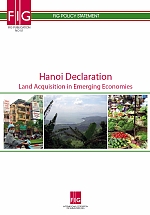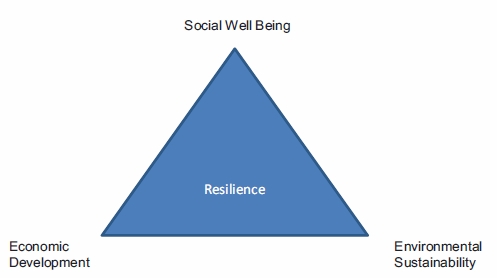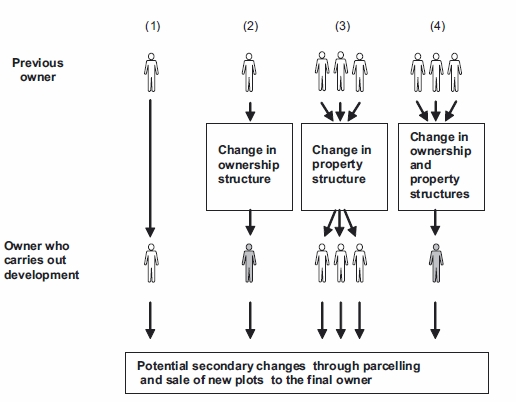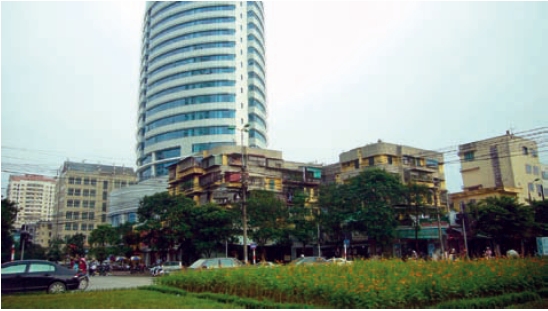

FIG PUBLICATION NO. 51Hanoi Declaration
|
 |
|
|
 |
This publication as a .pdf-file (28 pages - 1,115 MB) |
Hanoi Declaration on Land Acquisition in Emerging Economies
2. Problems in land acquisition
Market acquisition systems
Human rights based acquisition models
Problems in implementation in practice
Resilience
3. Tools in land acquisition
Direct tools
Compulsory Land Acquisition
Land Readjustment
Indirect tools
4. Building Capacity in Land Acquisition
Land delivery theory
Land delivery processes are cross-cutting
Land parcellation
Building land delivery
competencies
Land information system – government level
initiative
Anti eviction strategies – grass roots empowerment
Management of hard cases of land grabbing –
an initiative for developers
The 7th FIG Regional Conference 19–22 October 2009, held in Hanoi, Vietnam focused on Spatial Data Serving People: Land Governance and the Environment – Building the Capacity. This theme was chosen to address some of the key professional issues in East Asia and especially in the host country of Vietnam. The conference recognized that these regions require urgent action especially in terms of reinforcing methods for land acquisition in fast growing urban areas in developing economies.
This document deals with a number of issues: understanding the key problems in land acquisition in a way which ensures effective and efficient outcomes, including appropriate levels of compensation payments; explanation of land tools available for the land acquisition; identification of paths to the competencies needed to support processes of land acquisition; and building institutional and professional capacity for managing land acquisition processes.
The publication should be seen as an a tool to support politicians, executive managers, decision makers and professional organisations in their efforts to deal with land acquisition in a fair way, based on legal standards, full compensation, and acknowledgement of human rights. Land acquisition should secure that adequate development opportunities are available while land rights and social sustainability are fully protected throughout the process.
The document is based on the presentations at the 7th FIG Regional Conference, 19–22 October 2009, Hanoi, Vietnam, especially the keynote presentations. Conference proceedings are available on-line at www.fig.net/pub/vietnam.
An expert group was appointed to prepare the document led by Prof. Kauko Viitanen, Chair of FIG Commission 9, and including Dr. Dang Hung Vo , President of Viet Nam Association of Geodesy, Cartography and Remote Sensing (VGCR), Prof. Frances Plimmer, Chair Elect of FIG Commission 9, and Mrs. Jude Wallace, lawyer and senior consultant on legal land issues.
On behalf of FIG I would like to thank the members of the expert group and all the specialists who contributed to this publication for their constructive and helpful work.
| Stig Enemark FIG President |

Ha Long Bay, Vietnam
Hanoi Declaration on Land Acquisition in Emerging EconomiesThe International Federation of Surveyors (FIG) acknowledges land acquisition is a complex area that can be practiced in many ways. Basically, land administration systems must be able to manage the delivery of land for essential developments, private sector development and changes of land uses in response to evolving social and economic demands. Land acquisition may be carried out through voluntary agreements or through compulsory means (such compulsory purchase) to secure land delivery for development. In these processes good governance is fundamental to achieve the benefits of the protection of formal property rights and informal land uses. The declaration therefore recommends that a number of aims are taken into account:
These issues are all addressed in some details in this document. Land acquisition is a global and complex problem area. The land professional has a range of appropriate professional and technical skills and experience, and therefore is well placed to assist with many of the decisions and support activities. The land professional has the expertise to facilitate interaction and debate among a diversity of professional, political, economic, environmental, and community organisations, and to help jurisdictions achieve appropriate and sustainable solutions. FIG believes that land professionals, such as surveyors, have key roles to play in supporting the setting of strategies and policies; and facilitating interactions of professionals, politicians and local communities to secure legal and equitable processes of land acquisition, thus improving sustainable management of urban and rural areas in developing economies.
Prof. Stig Enemark |
Land is a unique and finite resource, essential for all human activities. The global population is increasing and more and more people are moving to urban areas. More land is needed for housing, employment, infrastructure and services within increasingly small geographical areas. The reduction of carbon emissions and pollution require urgent and effective solutions e.g. in reducing energy consumption. Sustainability is a key word. To reach that goal the actions have to be flexible and resilient.
Management of spatial change and implementation of essential physical structures require land to be put to appropriate uses. Both the public and the private sectors have to be able acquire land and/or change its present use. The public sector normally has insufficient resources to carry out all necessary activities. The private sector may need to provide additional initiatives and risk bearing capacities. However, private sector investment requires capacity and procedures to achieve the desired outcomes, including a profit margin that should be established through legislation. A key strategy for the public is to provide local infrastructure and relevant public services, particularly health and educational facilities, and to encourage individuals and private companies to locate themselves in areas that accord with the land use plans that reflect the wider and evolving needs of society.
Countries and regions use a variety of approaches to implement their adopted land use policies. A country may rely on a predominantly public sector approach or one led by the private sector. In each case, a number of mechanisms are available to ensure that plans and policies will be implemented. However, in each case there are risks that human rights will not be appropriately protected. For example, if the existing legal and procedural requirements do not adequately reflect modern expectations of fairness and equity, outcomes, legal frameworks and established processes are likely to have adverse impact on human rights. Moreover, bureaucracy, ineffective processes, corruption, and lack of resources and capacities undermine sustainable results. In worst cases, essential development will not be achieved.
Fast developing regions typically experience extensive and complex problems that need holistic solutions. The ability of communities to resist the adverse effects of population increase and climate change and to adapt to new demands depends on the capability those communities to change and manage their legal, policy, planning and development environments.

Hanoi, Vietnam.
Land Acquisition ToolsKey means of land acquisition include:
Other means of supporting land delivery and land development include:
A range of other means can also be considered, such as public−private partnerships that are potentially very useful for implementing larger development and regeneration schemes. Source: Williamson, Enemark, Wallace and Rajabifard (2010) |
Land administration theory identifies a series of tools for land delivery consistent with good governance. Standard tools that deliver land for private and public purposes fall into two broad categories: market acquisition systems and human rights based acquisition models. In addition there are practical, often political-related problems.
In developing countries use of formal land markets as a land delivery mechanism fails to meet the tests of capacity. Four common problems are well documented:
The human rights model of compulsory land acquisition is still under construction. In broad terms the model seeks to resolve the problems that arise in countries with predominantly informal land markets which seek to use market based solutions to fix compensation. The model adds additional components to land delivery processes designed to empower land occupiers and owners. In broad terms, these components demand land takers to:
Most of the large international institutions apply some or all of these standards for land acquisition or compulsory purchase designed to both respect the rights of existing land users and owners and to deliver secure tenure to developers, especially for public projects and projects funded by development aid. However, this is by no means the case for all acquisitions.
A common critical issue is that the legislation for land acquisition focuses more on arranging for the delivery of land for development rather than on achieving the necessary provisions for the social sustainability of affected people and communities. For example, compulsory land acquisition measures can be applied in commercial investment projects with the full involvement of the administrative system, although there is poor consultation between the current land-users and the investor, and poor control over the bureaucracy, the administrative systems and their officials.
In some jurisdictions, legal provisions on market-based land valuation are often missing from the legislation; long term benefits for affected land-users and residential community are not secured; and transparent mechanisms to allow the community and social associations to participate in the compulsory land acquisition process are absent. As a result, affected land-users do not always receive adequate compensation for resettlement or support for alternative accommodation, livelihood and employment. Complaints related to levels of compensation and resettlement still account for the majority of all complaints received.
In practice, acquisition of land in use for investment projects can face big challenges:
The concept of resilience provides a useful perspective on sustainable development. At its core is the idea that development processes should not and must not threaten the ability of future generations to share the earth’s resources, as previous generations have been able to. State and regional governments, multi-national corporations, local industry and the individual inhabitants are under increasing pressure to balance economic growth with social responsibility, including good governance, ethical practices, and respect for human rights and traditional cultures. Resilience can be regarded as an operational tool for recognising, improving and measuring corporate sustainability. Resilience is basically about recovering from and adapting to change. It is stressing the importance of achieving effective change for social and economic stability and environmental improvements. There is an inextricable relationship between social wellbeing, economic development and environmental sustainability as shown in Figure 1.

Figure 1: Relationship diagram between social wellbeing, economic
development and environmental sustainability (FIG 2008, p. 13).
Land acquisition can be practiced and improved in many ways. The main ways can be classified as direct and indirect. Public authorities like municipalities or state authorities may have the main role in both options depending on the legislation and culture. Indirect ways are normally used to encourage and stimulate private developments.
If the public authorities choose to carry out an active direct land policy, they are normally able to acquire land to achieve their development objectives through private agreements with the land owners and users. If these voluntary efforts are not available or successful, they may acquire land in the public interest through the process of compulsory purchase which includes the payment of compensation which normally is intended to equal the economic losses of the land owner.
“Public interest” may be defined to include construction of public roads and parks, provision of services and utilities such as drainage and sewerage, and installation of social facilities like schools and health clinics. In some jurisdictions, it can include housing for open market sale, industrial development and even regeneration projects. The need to implement an adopted land use plan may also be considered to involve public interest.
In most countries local or regional authorities and utility companies are responsible for providing and maintaining local infrastructure including roads, water supply systems, sewage systems, and communication networks. In some cases, however, a private developer may undertake some of these responsibilities as part of implementation of a major project based on a special agreement with the authorities. The costs of these infrastructure facilities are normally paid by the end users through fees calculated according to local rules or prices set by the market place. Major infrastructure facilities, such as highways, airports, ports, bridges, major electricity transmission lines, might be undertaken by state authorities or sometimes contracted out to international companies and infrastructure developers, on a specially negotiated “build, operate and transfer” arrangement.
Land may be acquired and held by public authorities in a land bank in order to control the supply of land for development in the region. These strategic purchases allow a municipality, for example, to control future development by disposing of serviced land in stages. In some jurisdictions, acquired land that is not used for the purpose for which it was originally purchased or is deemed superfluous to requirements within a given time period, must be offered back to the original owner or sold on the open market.
Direct tools for plan implementation can be divided in three main groups: voluntary agreements, compulsory land acquisition and land readjustment procedures. The differences between the procedures used to implement a tool need not be precise. For example, voluntary agreements may be used under the threat of compulsory acquisition if negotiations break down. Voluntary land acquisition may be used by the public or private sector, including private developers. The rules and processes are usually very similar. Compulsory purchase, however, is normally a tool used only by public bodies, although in some jurisdictions the compulsorily acquired land may be transferred directly to the private sector for development.

Figure 2: Four models to adapt the ownership and property structure to changes in land use (Kalbro 1992).
In a normal development project, the land in question is already in the
possession of one or more owners and users or is acquired through purchase,
expropriation or a similar process (Figure 2, cases 1, 2 and 4). The developer
(public or private) will then (usually) produce a development plan (detailed
plan) in co-operation with the municipality, obtain the necessary permissions,
and implement the project. However, placing an entire development area where
fragmented property and ownership structures exist into the possession of one
owner or user is both expensive and time-consuming (case
4). Development projects are therefore often difficult to accomplish. For
example, even though land may appear well suited for a particular development,
this may not be the view of the present owners and users or the surrounding
community. Opinions on the nature, course and timing of the development project
may differ, as can the willingness of the various land owners and users to
participate or take risks. There may even be a lack of resources to implement
the project. The development may thus be delayed for a considerable time which
generally results in increasing neglect and dereliction of the area as owners
see the futility of investing in land and buildings which are destined for
demolition. As a consequence, in a number of countries, e.g. Japan, South Korea
and Thailand, several types of legal instruments for urban land readjustment
have been elaborated in order to ease predictable difficult situations. (Figure
2, case 3).
Compulsory purchase (expropriation or eminent domain) is an important tool in most of countries for land acquisition for public purposes, although in many countries land acquisition can often be arranged through other means, e.g. by voluntary agreements.
In developing countries, adequate legislation and government capacity can be an initial problem. Countries which give strong constitutional protection to land ownership restrict opportunities for compulsory acquisition, sometimes with fatal results for public projects.
For many countries, e.g. those sharing common law heritage, compulsory acquisition is a familiar method. The overarching ability of governments to take private land for public purposes is generally unquestioned. The opportunity of the government to take land is regulated by legislative processes and familiar standards of acquisition. These standards apply normally to private land but sometimes also to public land held by another authority. Some reasons often mentioned for the use of compulsory purchase include:
Market systems may encourage the owners’ expectations to be compensated at a value equivalent to commercial or market value as estimated by a professional. Where a free, active, transparent and formally organised land market operates, governments are able to offer market based methods of land delivery that are not available in countries with informal markets. Countries with formalized processes generally experience minimal human and social consequences for land delivery, and use systems of compulsory acquisition which manage the free rider problems associated with opportunities to for land owners and users to refuse to transfer their land in order to get a substantially higher price. Compulsory purchase is not, however, the primary method for land acquisition. For example, the acquiring authority can acquire a poor public image by insisting on a compulsory process. The process however remains available where the land acquisition is not possible in a more socially acceptable way.
The compulsory purchase procedure normally has two phases.
The costs of the proceedings are paid by the expropriator. The land or user owner is normally entitled to be compensated for the land acquired, depreciation in the value of any land retained, but also necessary costs, such as moving, travelling, expenses for professional help, and loss of earnings. The decisions on the expropriation can be appealed. It is important that the expropriation and compensation be handled smoothly, swiftly and in a fair and equitable manner. In this way the costs may be reduced and all parties should be satisfied.
Owners and occupiers who are being expropriated or dispossessed generally expect to receive just and full compensation. However, there is no universal principle for expropriation of property. Countries with a common law system recognize that compulsory acquisition does not exist at common law, and therefore, rights to compensation cannot exist at common law. Because compulsory acquisition is a creation of statute, the right to compensation must also exist within statute – these rights cannot be inferred, regardless of the unfairness which results to the land owner or occupier. While it may be socially desirable and generally expected that the land owner’s financial situation remain the same despite the expropriation, non economic losses are not usually compensated. There are normally no strict rules, for example that the owner or user must be able to purchase a similar property for the same price although the popular understanding of compensation may assume this. In reality the concept of “just or full compensation” is entirely dependant on the legislation and its interpretation in each country. The main rule for the assessment of compensation for the property acquired is generally presented as the market value of the land acquired, which normally means a market value calculated from comparable real property transactions. However, this can be defined in a way that prevents the expropriated owner using the compensation to purchase a comparable property in the same or a similar location because the development value created by the acquiring authority (and which is recognized within a market value) is excluded from calculations of the amount of compensation payable.
According to the textbooks, in some jurisdictions, the compensation should
cover the objective value (market value) of the expropriated property, the
depreciation of the value of any retained property (injurious affection or
severance), and other damages (e.g. loss of profits) and costs (e.g.
professional fees) which will weaken the financial situation of the expropriated
owner or user: TC = (V + S + D) + C, where
TC = total compensation
V = compensation for the expropriated property
S = compensation for damage due to injurious affection or severance
D = compensation for other damages
C = compensation for costs (additional payments).
There are, however, some problems concerning the assessment of compensation. If the make up of the final payment is split in this way, there is no certainty that the land owner or occupier will receive the full compensation. Especially in cases involving a private expropriator, the grounds for calculating the amount of full compensation can be questioned. A certain margin of safety in relation to the amount estimated by conventional valuation methods is often allowed. Some cases may even justify giving a share of the expropriator’s profit to the owner or user. Also a share in a development corporation could in certain cases be an option to allow the land owner to participate in the development and the profit produced.
In practice compulsory acquisition is not a very widely used method. It is often seen as a complex process that takes long time and is expensive both in terms of the cost of the process and the delay in implementing the development, although there are, however, examples of well functioning processes. In addition, interference with private ownership by compulsion is often not considered appropriate, and gives the authority a poor public image in the media. Political decision-makers who favour expropriation often fear a drop in their popularity.
In many countries registration of proprietary rights and usufructs is still rather uncertain. Various permissions are poorly documented or the need for permissions is poorly understood by citizens and investors. For example, within an informal settlement, the compensation would remain totally unpaid if claims are only accepted from registered owners. Practical examples also show that compensation payments may be delayed or may never materialize e.g. due to the expropriator’s lack of capital or corruption of the authorities. People lose their dwellings and even their means of making a living by cultivating parcels of land, without being able to purchase alternative ones. There are also regions where new usable pieces of land are not available, even though the compensation is paid. In these kinds of cases, where there is no supply or even no functioning market, expropriation based on compensation in money seems to be inappropriate and new methods more adaptable to the circumstances are required.
The urban land readjustment procedure can be considered either as a method for urban land development (by land owners) or as a tool for planning implementation (by institutions on behalf of the wider society). Different countries have reached different solutions depending on, for example, the planning system already in existence and their attitude towards the responsibilities of the private and the public sectors in producing land for development purposes. In practice, however, the differences are less dramatic than one might think.
A development process in connection with the urban land readjustment procedure does not differ from a “normal” land development process in the main stages, which, according to Kalbro (1992) are: initiation, land acquisition, planning, financing, permission by the authorities, construction of the infrastructure and buildings, and evaluation of the project. Generally speaking, all of these stages can be implemented by the urban land readjustment procedure and a pool of land owners and users (a readjustment association) instead of by an individual developer. At the very least, the readjustment procedure can be regarded simply as a method for changing the division of land. The land is serviced and part of the land (sites) is sold to cover the cost of the project, and the rest is divided between the original land owners and users according to the original land area or value depending on the agreement or the requirements of the jurisdiction. Also a land use agreement can be reached with the public bodies and the development of social housing or other socially beneficial outcomes may be connected to the procedure.
The urban land readjustment procedure is very closely linked to detailed local planning and other land use planning. Normally urban development is based on plans approved following a public consultation process, while the urban land readjustment procedure may be carried out in a number of different ways. At its simplest, the urban land readjustment procedure only implements the existing plan without the processes themselves having any similarities. Planning and the urban land readjustment procedure can even be integrated into one process to obtain synergetic benefits, better participation, cost and time savings, and improved plans. This might, however, produce difficulties in the organisation of the functions and in the co-operation between the various processes.
In practice, the extent of the readjusted areas varies from large – more than one hundred hectares – to small – less than one hectare. The areas to be redeveloped may be “greenfield” (i.e. previously undeveloped) or urban “brownfield” or run down sites. In the readjustment process the parcels of land are notionally assembled in one plot, where the joint owners have a share according to the acreage of the property owned by each or according to the value of the land owned before the procedure began. The site will be shared between the joint owners, so that each of them receives a share of the readjustment area and the real estate boundaries are adjusted according to the detailed plan. Public areas are usually transferred to the municipality, the rights relating to real properties rearranged, any necessary compensations are determined, the infrastructure required for the area may also be implemented, and the financing for its development obtained. The construction of building sites is usually not included in the readjustment procedure or calculations. The costs for the readjustment procedure are covered either by the land owners and users or the municipality, or by all jointly. In order to cover costs, the municipality usually has the right to a share of the profit resulting from the readjustment procedure in the form of parcels of land.
The urban land readjustment procedure is justified not only on the basis of cost and efficiency but also on the basis of its equitable treatment of land owners and users, improvements in the quality of the resulting development, savings to the community, and environmental benefits. Under normal planning conditions the land owners and users may avail themselves of the land value increase or reduction, depending on the intended use according to the plan, i.e. the value of the property may increase considerably or even decrease. In the readjustment procedure the land value changes can be fairly and equally divided between the land owners and users. The procedure will therefore also inhibit speculations about planning. As the existing property boundaries can be ignored when preparing the plan, the variety of potential plan solutions will increase with improvement in the quality of the resulting development. At the same time the existing social structure can also be maintained (in contrast to a situation where expropriation of the area is used). Especially with smaller-scale developments, small entrepreneurs, owners and users are often prepared to invest in the development of their area with little expectation of profit, but only if they feel the original unsatisfactory situation in their area will be improved. The participation of the original land owners and users cannot be directly measured simply in terms of money, however they should have at least some chance of obtaining a share of any future profits.
When cities expand, construction and maintenance costs for the infrastructure increase considerably as do risks of environmental damage. Implementation of the urban land readjustment procedure in areas within the existing urban structure or neighbouring undeveloped or under utilized areas should result in cost savings, reduced pollution and help preservation of the social and natural environment. In addition, as the procedure can also be implemented in areas that would otherwise be difficult to include despite their favourable urban structure and environment, further considerable cost savings can be achieved and environmental damage minimised.
The urban land readjustment procedure is not, however, a trouble-free instrument. The processes needed are often very demanding and complicated and require those involved to display considerable expertise. The decision-makers should also be familiar with the operating mechanisms and options so that implementation of the procedure is not jeopardised by ignorance. Political, administrative and professional conflicts of interest can also come into play, sometimes resulting in an ineffectual adoption of the procedure. However, because of its many positive benefits, the urban land readjustment procedure has already survived for a century, and seems free from threat where its use is common, parties are familiar with the processes and its advantages are well recognised.
The state or municipality can use many different options to facilitate sustainable development or prohibit unsustainable development.
The indirect tools most closely connected to land development include building prohibition and subdivision prohibition or subdivision permission, pre-emption and financial incentives. Prohibitions as to permissions seek to avoid unwanted buildings or other kinds of land uses in what the authorities see as inappropriate locations. They are commonly used in many developed countries.
Pre-emption rights require the land owners and users in principle to offer their property for sale to the municipality or state first, normally at what may be described as the market value. In some countries, e.g. in Finland, the municipality has a certain period of time to decide to replace the original buyer if it sees that as sensible. These rights can be used in different forms to ensure that the wider public interests can be achieved in particular areas.
Financial incentives may include subsidies to encourage specific developments at a certain location and time. These can include low land prices, property tax abatement over a number of years, low cost development loans, and many other strategies. In some countries, however, the public authorities are not entitled to offer economic incentives. In Denmark for instance, the activities of the public authorities are limited under the general principles of equality and objectivity; and those activities must not intervene in the general conditions of the market or benefit individual persons or companies.
Many other methods, including the popular public-private partnerships, are potentially very useful for implementing larger regeneration schemes e.g. when regenerating old industrial areas, so called brownfield sites, into modern urban sites often with multiple land-uses. These methods include promoting and marketing mechanisms for branding specific developments.

Ho Chi Minh City, Vietnam.
Land administration systems must be able to manage the delivery of land for essential developments, private sector development and changes of land uses in response to evolving social and economic demands.
Developing countries often lack clearly articulated theories that underpin state power to acquire land, especially if the two basic approaches of civil and common law used in market based economies are inevitably associated with pre-independence colonial experiences. The starting point in these countries lies in framing clear and comprehensive constitutional framework and laws that establish the basis for taking land in situations of unwilling sellers and occupiers, ideally incorporating the human rights standards for resettlement, adequate levels of compensation, and which reflect the needs and expectations of their societies. Often laws along these lines already exist. The problems lie in other directions.
Even from a narrow perspective, land acquisition forms the operative intersection of processes that manage land markets, administer land tenures and implement land use planning. Land acquisition is therefore a complex cross-cutting issue – an issue which is approached in each country, indeed in each local jurisdiction, according to processes drawn from a variety of land administration functions, and often from an historic perspective. In modern land administration theory, the functions of land administration are land tenure, land value, land use and land development which, if the land management paradigm (the method of understanding how the multiple processes work) is applied, are designed to deliver sustainable development (Enemark 2009).
All four functions are involved in land delivery. In countries where all processes are formally organised, land development involves exhaustive and extensive consultation processes related to planning and zoning, and highly professionalized services from government and private sector professionals at every stage. The processes tend to be more transparent and susceptible to public scrutiny than secret.
Developing countries often lack the capacity to build equivalent processes and often rely on non-government organisations (NGOs) for a range of expertise. Their major incapacity however tends to be in technical areas. Creation of new land parcels (subdivision) is often a major stumbling block. Even a very simple project involves the formal identification of land for development purposes, and the subsequent conversion of raw land or the rearrangement of formed parcels into the appropriate development parcels. Whether the market based or human rights models of land delivery are used, adequate and appropriate technical services and administrative capacity must be developed.
Most land administration systems in developing countries lack the capacity to
reorganize land parcels. Parcellation includes the establishment of the
boundaries of the development area, coherent arrangements with neighbouring
parcels, the identification and agreement of the tenure of the developer, and
the provision of infrastructure, including roads, public transport, drainage,
electricity, cable services, sewerage, water and so on, at the basic minimum
level. These processes of subdivision and consolidation of land are often
imperfect, even with the aid of commercial funds and professional project
advice. In South East Asian cities, for example Hanoi, existing parcels are
frequently small scale, making reconfiguration of land for modern developments
difficult, time
consuming and therefore expensive.
The divergence between existing land uses and newly formed parcels is often profound and compounds reconstruction and compensation issues. Discrimination between legal and illegal land development distributes compensation unfairly, and leads to operative paralysis in those developing countries where “legalised” processes for land use planning, development and tenure regulation are not available or not implemented. Determination of “ownership” of land among urban dwellers is often not precise even with a boundary system.
Within this array of complex issues, three “break through” tools can improve land delivery processes:
These tools are not new. They are supported by their own body of research and experience and they are generally within the competence of most governments. While they are independent of a country’s ability to reach over-all compliance with good governance indicators and land governance indicators, they help comply with them. The tools are presented in more details below.
In the vacuum of professional surveying capacity, most developing countries increasingly rely on land information systems (LISs) moving into cadastral surveying as resources become available. A geographic information system (GIS) based LIS is one of the emerging new tools available through new spatial technologies. A systematic tool that relates GIS, remote sensing and field surveying is described by UN-HABITAT (2008). The tool produces a comprehensive but quick and inexpensive information system to support a range of functions, especially land use planning and property taxation. The results do not replace, and indeed cannot replace, cadastral surveying that gives precise parcel mapping, scientific coordination of legal boundaries with plan information, and land use identification. A GIS based LIS, however, offers obvious advantages for managing demographic movement, consultation, and planning processes associated with land delivery and especially compulsory acquisition.
Countries with inadequate land administration systems and informal markets almost inevitably use forced evictions in land delivery processes. Many evictions, including those based on national legal enforcement orders, ignore the international and constitutional legislation which guarantees the right to housing and other human rights (UN 2007). These follow the definition of minimum security of tenure as the rights of individuals and groups to effective protection by the state against forced evictions (UNHABITAT 2002). The strategic impact of flexible legal formulae, like anti-eviction laws, were further explained by Augustinus and Benschop (2007).
In land acquisition processes, these anti-eviction laws empower local people to claim a role in negotiations related to a development in which they have an interest, especially if the laws provide a clear underlying opportunity for them to complain to courts if they are ignored. The strategy is therefore focused on capacity building at grass-roots level rather than at government administrative levels. Good governance indicators are therefore tested in the general courts system where they are demanded as part of national ability to use a rule of law.
Land grabbing is a common and negative aspect of land delivery. It causes long lasting tensions, denies individuals of the financial means to relocate themselves and to be economically useful and independent, and undermines civil peace. Criticism of governments in most developing countries for their failures to meet international standards for management of land grabbing seems to be unhelpful.
Governments need help and support in order to establish formal capacity to manage their land delivery systems, for instance along the lines of the recommendations for a code (von Braun and Meizen-Dick 2009). This initiative involves the strategic engagement of foreign investors and their host countries in adopting a self imposed code of conduct for investment in land, and in particular, agricultural land. The code assists target countries to strengthen their policy environment and implementation capacities by combining their efforts with those of investors. The range of terms and conditions suggested in the code delivers “win-win” solutions for all. The issues covered are much wider than mere land administration standards, and include the implementation of good governance standards (transparency) and human rights based standards to protect local people while delivering essential development opportunities.
From the World Bank perspective a large part of the institutional problems associated with the demand for land and natural resources for development is directly related to civil service capacity to effectively address these issues. There are a number of specific, key areas where additional capacity development needs must be focused. These may relate to (Bell, 2009):

Hanoi, Vietnam.
The new approaches in land administration encourage civil society, developers and governments to use new tools in land delivery processes. The broadening of land administration theory into multi-disciplinary competence is both welcome and essential. The addition of non-technical goals in building sustainable systems is compatible with the articulation of standards and guidelines on land acquisition.
No developing country is in a position to apply best practice methods throughout its entire suite of land administration processes. However, the lessons from land administration and good governance theories are capable of informing a change of strategies in most countries. Indeed, many of the less developed nations are in a better position to adapt their systems to modern standards than are economically successful nations where the legacy of systems and technologies inhibit substantial change.
Land development is a constant in all nations and the management tools selected by a country need to be developed in the context of its own needs and capacity to contribute to overall good governance and sustainability. Compulsory land acquisition, whether for development aid projects or private projects, needs tools that work at the country and local levels. Unless appropriate tools are selected, land acquisition planning associated with development aid and project financing will concentrate on identifying standards for the social processes associated with movement of people away from the development site and into replacement sites, which will fuel the ever growing problems of informal urban settlements. Guidelines will miss the point that most countries need to build capacity to undertake the scalable and technical land delivery processes. Other tools have unforeseen consequences. A clear and comprehensive legal framework is always recommended; however, legalism and formalism can paralyze land delivery, even for essential public infrastructure projects, a problem now evident in Indonesia.
From the perspective of capacity building in land administration, efforts to define land delivery processes must improve technical capacity to use formal systems to manage the creation of parcels. Reasonably transparent processes and formal systems that facilitate parcel identification, resilient boundaries and use of a large scale base map using modern spatial technology to record coordinates are long term improvements that will assist the removal of residents and occupiers and their resettlement in permanent “formal” homes and alternative and realistic work opportunities.
Each country will develop its own path. Strategic changes are urgently needed to modulate the opportunities of local people, developers and governments in ways that produce long lasting and sustainable results.
For example Dr. Vo recommended a revision of the current Land Law of Vietnam, focusing on the following issues:
Furthermore he recommended improvement of land policies to ensure the efficiency of their practical implementation and to target both economic development and social sustainability. Other specific recommendations include policies with regard to voluntary benefits sharing, promotion of the participation of communities and social organizations, strengthened opportunities for dialogue between the government and the people, creation of real consensus in relation to investment projects across all parties, and enhancement of inspection and evaluation works by upper level administrative authorities over their lower level ones.
Good governance is fundamental to achieving the benefits of the protection of formal property rights and informal land uses that deliver livelihoods for millions of people. The development of efficient and effective land and property markets, social development and economic prosperity also depend on good governance, as does efficient and effective stewardship of the environment and natural resources. Governments with a record of transparency, accountability, stability and responsiveness are far more likely to attract investment, provide high-quality public services and manage resources more cost-effectively than those whose activities are opaque and not open to public scrutiny. Corruption may breed where government officials have discretion without accountability, especially in government agencies involved in provision of services to the public including land.
Good governance in land administration is not a new issue, and is as important in the developing world as it is in developed countries. Efficient, effective, transparent and accountable land administration services are as much about the administration of land as they are about the public service and institutions that operates within any country. Typically, reform of land administration in any country is a long-term prospect requiring decades of sustained commitment. It involves a major investment of capital and human resources and requires strong and consistent leadership in order to achieve effective, sustainable outcomes. In post-conflict countries, tenure security and access to land are major factors in providing the long-term stability that supports the development of transparent land markets capable of generating durable results.

Hanoi, Vietnam.
As mentioned in the foreword this document is based on the presentations at the 7th FIG Regional Conference, 19–22 October 2009, Hanoi, Vietnam, especially the keynote presentations. Conference proceedings are available on-line at www.fig.net/pub/vietnam
Further references and bibliography are:

Hanoi, Vietnam.
Published in English
Copenhagen, Denmark
ISBN 978-87-90907-82-2
Published by
The International Federation of Surveyors (FIG)
Kalvebod Brygge 31–33, DK-1780 Copenhagen V
DENMARK
Tel. +45 38 86 10 81
E-mail: FIG@FIG.net
www.fig.net
February 2010
ACKNOWLEDGEMENTS
Editor: Stig Enemark
Cover photos: Front cover: Hanoi, Vietnam (left), Central Vietnam (middle) and
Ho Chi Minh City, Vietnam (right) © Stig Enemark
All photographs: © FIG
Design and layout: International Federation of Surveyors, FIG
Printer: Oriveden Kirjapaino, Finland
Hanoi Declaration
Land Acquisition in Emerging Economies
Published in English
Published by The International Federation of Surveyors (FIG), February 2010
Copenhagen, Denmark
ISBN: 978-87-90907-82-2
Printed copies can be ordered from:
FIG Office, Kalvebod Brygge 31-33, DK-1780 Copenhagen V, DENMARK,
Tel: + 45 38 86 10 81, E-mail:
FIG@fig.net